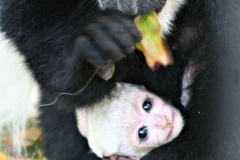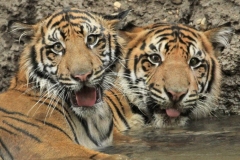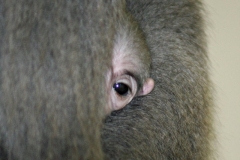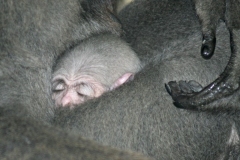
News release from the Fort Wayne Children’s Zoo:
Zoo’s Red Panda Cub Reaches Milestone
(July 11, 2014) – Now 30 days old, the female red panda cub born at the Fort Wayne Children’s Zoo on June 9 has passed a critical milestone.
“About half of all red panda cubs die within 30 days after birth,” says Animal Curator Mark Weldon. “We are obviously pleased that our cub has made it this far.”
This is the third litter of cubs to be born to female Xiao (pronounced JOW), age 5, and her 6-year-old mate, Junjie. Two cubs were born to Xiao in 2012, and a single cub was born in 2013; none of these cubs survived longer than two weeks. Red pandas are an endangered species.
“We remain cautiously optimistic about the cub,” said Shelley Scherer, who supervises the Central Zoo and Australian Adventure. “This cub was born healthy and had an above average birth weight. Xiao is also a more experienced mother, which has certainly been a factor.”
“This cub is feisty, squirmy, and chubby,” said Zoo Keeper Helena Lacey, who works with the red pandas daily. The cub has not yet been named.
Though the cub has survived the first 30 days, she still faces other hurdles. “Weaning is a critical time for red panda cubs as they make the transition from mother’s milk to solid food,” explained Lacey. Weaning occurs when the cub is five to six months old.
The path to the red panda exhibit remains closed to zoo guests in an effort to minimize disturbances for the new family.
Xiao and her cub spend nearly all of their time in an air-conditioned nest box within the red panda exhibit, where Xiao nurses, grooms, and sleeps next to her cub. This is natural behavior for red pandas, which nest in hollow trees in the wild. Cubs typically remain in the nest box for about three months. This means that zoo guests have little chance of seeing the cub until late August or early September.
Zoo keepers monitor the duo via a remote camera mounted in the nest box. “They sleep most of the time, but we also see Xiao grooming herself and the cub,” said Lacey. Xiao leaves the nest box several times a day to eat and climb in the exhibit while her cub remains in the nest box.
Three to four times a week, zoo keepers distract Xiao with a tasty bamboo branch and quickly weigh the cub. So far, the cub is gaining weight and has more than tripled her birth weight of 139 grams to 454 grams (about one pound). Twice a week, the veterinary staff performs a brief exam on the cub, checking for any abnormalities.
The cub’s eyes are now open. The baby squirms and squeals during her weigh-ins and checkups – signs of a strong and alert cub. At this time, the zoo staff sees no need to intervene by hand-rearing the cub or offering supplemental feedings, though protocols are in place should the need arise.
The breeding of red pandas is overseen by the Species Survival Plan (SSP), a program of the Association of Zoos & Aquariums (AZA). The goal of the SSP is to maximize genetic diversity in zoo-dwelling populations of endangered and threatened animals.
Red pandas are native to the forested foothills of the Himalaya Mountains in China and Nepal, where they feed primarily on bamboo. Though they share a name with the famed black-and-white giant pandas, the two are not closely related. The name “panda” comes from the Nepalese word ponya, which means “bamboo-eater.”
About the Fort Wayne Children’s Zoo
The Fort Wayne Children’s Zoo is northeast Indiana’s largest tourist attraction, hosting more than 500,000 guests annually. The zoo was voted Indiana’s #1 “Gotta-Do Summer Attraction” and is consistently named one of the nation’s Top Ten Zoos for Kids by national media outlets.The zoo is a conservation leader, contributing more than $80,000 annually to local, regional, and international efforts to protect wild animals and habitats, and participating in cooperative management programs for 15 endangered species.
As a self-supporting facility, the Fort Wayne Children’s Zoo receives no tax dollars for operations. The zoo’s operations are funded entirely by earned revenue and donations.
The zoo is open 9:00 AM – 5:00 PM daily through October 12, 2014. Admission is $14.00 for adults; $10.50 for seniors age 60+; and $9.00 for children ages 2-18. Babies age 1 and under and Zoo Society Members are admitted free.
Related weblinks:
- Photos available at: https://bit.ly/FWCZBabyPanda
- Video available at: https://youtu.be/4tJZivO_N7Q
- Fort Wayne Children’s Zoo website















